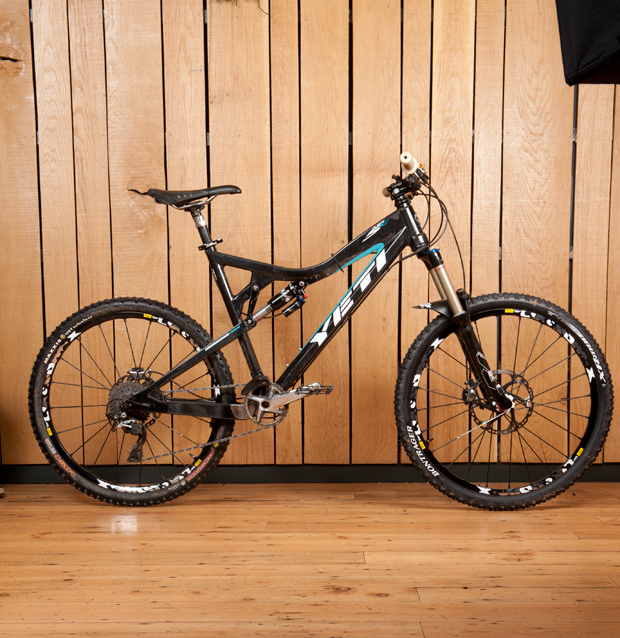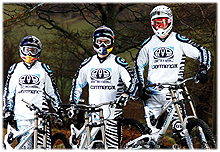Mutiny on the Bounty. Steve Jones tells us his thoughts on the bikes with the big wheels.
ALL HANDS ON DECK MR CHRISTIAN THE 29ER IS FASTER AND HAS TAKEN OVER.
The need for speed and fun is central to everything we do on two wheels; Steven Jones takes at a look at the 29er bike to see whether they really do deliver or if it’s just a case of the next big thing.
Clarity and the 29er bike have lacked unity for too long. A mix of cynicism, fence sitting and reluctance to stray too far from the common ground are only part of the story. The message from California has been slow to arrive. Or blocked. Maybe not surprising given the politics of the subject, the fact there’s an Olympics next year and a bunch of my mates are going to hate me for saying this because ultimately it might mean their bikes are just about to become out-dated.

Of the ways to get a bike across the Atlantic, sticking it in a box UPS direct from SFO would seem the most logical in terms of a physical product. The overall 29 bike message meanwhile has been stuck in a bottle, the industry having sent the paperwork down the slow route and since become lost in a mid Atlantic fog, stuck on a cargo ship run by militant sailors hell bent on dragging out the journey, hijacking and certainly not exactly eager to let anyone know the value of their cargo.
Shyness of the industry to push too hard, after all there’s one mighty big shed of bikes out there that could overnight become obsolete. For a business that prides itself in transfer of knowledge (bright ideas too) these boys have been startlingly introvert all of a sudden.
The 29 message has been staggeringly slow to get across. Like the Russian boat we all know its there but nobody wants to get on board for fear an outbreak of “yetanotherthingtosell” – the boat continues to drift, a Czech man wins the World Cup cross country series and still the boat drifts. Maybe it’s all a bit more sinister, gigantically political…. UCI bans skin suits from World Cup but hey guys you carry on using bikes that are inherently faster. A technicality maybe, but does anyone out there actually know the facts?
The media have not exactly helped. And hell there’s a lot of people within the mountain bike industry that really don’t like them BUT the industry is trying to sell them as the next big thing. More than that media comment nearly always involves questioning people from within the media and the industry their opinions. Much of this is largely insular, out-dated and clueless. Forums filled with garbage, 26 versus 29 forum debates in which there is seldom an opinion, never an outcome, purists stuck in a bog, downhillers basing everything on ten inch bikes and science background boffins telling us that it makes no sense. Conspiracy theory’s, Europe versus America, empiricism pirated…..yes this could be a big one.

Then there’s the general banter associated with the subject – hippy hardtail bikes, road biking on dirt, a good rider owns the terrain but not on a 29, there’s more to going fast than rolling, turns too slow and slow to flop left or right. More than that, professional World Cup cross-country racers are quoted as saying there is a weight disadvantage. Guys what the fuck are you thinking? Maybe too much of the following:-
THE ARGUMENT – AGAINST 29ers
Manoeuvrability – most arguments centre around the front centre/rear centre balance and the years of fine-tuning that 26” bikes have achieved
Acceleration – Larger rotational mass of the wheels is said to be slow in tight corners
Agility – You cannot pump and work a 29 in technical terrain like you can 26”
Weaker wheels – a theory that smaller wheels are stronger
Poor geometry – the designs are in their infancy
Limited designs – fewer companies producing limited designs
Rider height – said to be better for taller riders
Flow – not possible to pump terrain, flow corners especially tighter ones
Fall over – said to fall over in corners due to a higher centre of gravity
Unsprung mass – more weight in the rear will make the bikes harsher
Tyres and tube weight – increased overall bike weight due to such things as the rubber content
26” lighter and faster than ever – plus the Europeans are making some bloody good 26” trail bikes
Other issues that need solving before go 29 – for example gearboxes, mudguards
Conspiracy theories – the USA based companies desperate to make our garages obsolete
They look shit – people perception that bigger wheels look bad
The science – you cannot argue with a boffin after all
THE ARGUMENT – FOR 29ers
Traction
Cornering
Roll over
Taller riders
Less nervous
Better grip
Better flow, less nervy
Scale of large 26 bikes looks daft
Stability
Faster
Smoother on descents
ONE RIDER MANY HILLS
Below are my own thoughts and tests on the subject carried out on several bikes including – Santa Cruz Tallboy, Specialized Camber, Trek Rumblefish, Norco Shinobi and Charge Cooker.
It’s all about timing and perception, for the first week I struggled mightily on 29 for the sensation seemed so wrong and my technique as I was about to find out frighteningly inefficient. But the watch, I trusted would not lie. At the end of day one, testing on reasonably technical terrain (they hold a downhill race here quite often) the second hand was consistently 8-10 seconds down on 26” times. I had as I said to the uplift man ‘seen enough.’
A few more bikes arrived, Maxxis sent over some new Beaver tyres, I got some shorter stems fitted, I slowly racked up the hours, I felt myself settling on the tyres more, getting the timing better.
There was no doubt that climbing was quicker and soon found all the crap about acceleration was in fact totally untrue, maybe for the first few turns of the crank the 26 has an edge but your mate on the 29 will almost immediately be buzzing your tyre within yards. Chasing a 29 on a 26 becomes hard graft.

Santa Cruz Tallboy
Three weeks into riding 29ers I no longer sign up to the theory that 26 bikes offer great agility either. In fact I now find them more nervous and slower. For me it clicked on the Norco Shinobi amongst tight flat rooty corners, the place where I had previously been totally struggling to get any kind of timing and flow. Within a few turns and a change of style I found myself leaning, attacking and pulling away from my riding friend who shares similar speed. It was simply a moment of clarity, in an instant manualling, pumping the ground, confident and fully coherent of the timing required. In the mud the bigger wheel size translates to more control during the slide and certainly increased traction.
But ultimately what did it for me were the times versus what I believed to be quicker. The clock came out again, I changed some bike sizes. Over a variety of terrain from flat and rooty to steeper technical tight, wet and rooty terrain I put several more 29 bikes up against the proverbial king of the mountain 26 bike. Possibly the most state of the art 140mm bike currently available.
The 29 gave me my fastest descent ever of a particular section 2 minutes 45seconds. On the 140mm bike I felt I was about to totally destroy the times set on the big wheels – out of corners, through the rollers, balanced in the berms. But no 1 second slower. Since then I have increased the gap to 8 seconds
Onto the steep technical riding which previously proved so successful for the 26-inch bike I began beating the times previously set. I had to get back on the 26 to check again but no, still slower. These big wheel 110 and 120mm travel bikes were now simply consistently faster.
ADAPTION
To me time has shown that you can make the adjustment necessary and now I have fully found my feet on the 29 bike will find it difficult to ride bikes that are inherently slower for UK trail riding. I have found a change in rhythm, gained a faster speed.
And the fun? Poise under pressure, corner speed, camber hold, stability in the air and on the ground are just some of the things I like about the 29. I’m also riding smoother which might ultimately mean a change to spd pedals. For now the gains in traction in British winter are unquestionable.
The only thing sluggish of the 29 bike is the indolence of those that are quick to put down these bikes, taking jabs at a subject for who most have absolutely no idea – the 29 is all about speed, efficiency and in my opinion fun. The slow uptake might simply be down to riders getting riding time and the fact that there are still some bad examples.
Yes the testing is limited and its true the sticking point maybe the move to 160mm, but I tell you what, I’m relishing that day. I also cannot give an opinion what a smaller rider might feel. How long before we see small and medium bikes in 26 and large in 29/26 and XL in 29 only?
For now the 29er bike offers me a better feeling and faster ride in trail environment than a 26”. I’m not in any way giving a broad endorsement to all 29er bikes here – there’s good and bad examples of both size wheels – and maybe different riders will create different results, but at least lets get some facts.
For now, for the majority of trail riding I do on any bike up to 140mm travel I now believe I have an advantage by using 29inch wheels on certain bikes. The question whether faster is better, for me it’s a better experience. Can of worms opened…test to follow.
The boat drifts…All hands on deck Mr Christian.
Are you frightened to go around the horn Mr Christian?
Steven Jones.





